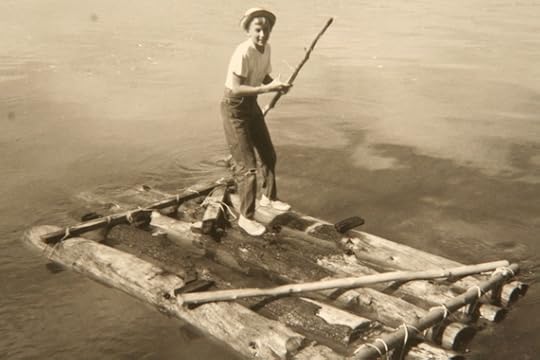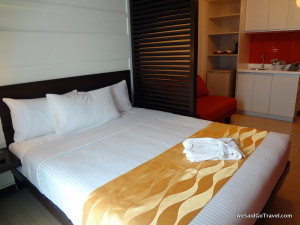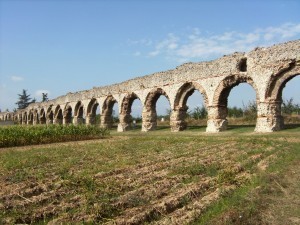Lisa Niver's Blog: We Said Go Travel, page 453
November 16, 2013
The Slow Travel Movement
Travel, of course, suggests movement, and adventure implies a well-planned trip gone wrong; yet when my partners and I started Sobek Expeditions, back in 1973, it was a radical departure from the typical travel provider train station, something perhaps akin to the Glacier Express, which bills itself as the slowest express train in the world. The idea was to take the long way, the multi-day trek over a pass, rather than motoring through the tunnel so that the world winds down and delight and enlightenment seep in.
The more granular you go, the bigger the universe. The meander is the beeline of poets, and we are all poets in some stage of reduction, unwinding the path, like a mountain trail to a spring. And the more we see the more we realize we have yet to see, the paradox of plenty.
William Blake presaged the movement in “Auguries of Innocence” when he wrote: “To see a world in a grain of sand, And a heaven in a wild flower. To hold infinity in the palm of your hand, And eternity in an hour.”
Richard Bangs on the fast raft to Wonder
Slow Food, of course, is the international movement founded by Carlo Petrini in 1986. Promoted as an alternative to fast food, it strives to preserve traditional and regional cuisine and encourages farming of plants, seeds and livestock characteristic of the local ecosystem.
We didn’t name what we offered in the travel space as “slow,” though that was the nature of how we designed and conducted travel, and now it has a proper designation, which is exciting. Today slow travel is an emerging movement, and can be applied in many ways, but I would boil it down to this: Slow travel is the deliberate deceleration of a journey so that the small looms large, the particle becomes profound, and the blood races with the adventure and discovery of the Amazon in every dewdrop, the Everest in every trail stone, the Redwoods in every swath of grass, and the galaxy within every snowflake.
Slow travel can be applied to any journey, as it is more about the noticing and absorption of all the available input, rather than the pacing. There have been movements when I was crashing through a major rapid when, as in a snapshot, I would freeze the world and drink in all the details, and then allow a mindful interpretation over time.
Slow adventure involves risk… the risk of discovering truth and meaning through examination. It’s not really a juxtaposition of active and passive, or rabbit and tortoise. You can choose any adventure, which often means an experience that ushers beyond a comfort zone, and fashion it to slow adventure just by opening eyes, arms and hearts a bit wider, and letting the delights, as well as the inconvenient, pour in.
I began my professional career as a river guide on the Colorado River through the Grand Canyon, and was then a card-carrying member in the cult of adrenaline. But with time I discovered that as many, if not more, thrills can be had by hazarding the mountains of mind, the incognita coordinates of the spirit, all of which are accessed through the legwork of the lingerer on the negligible trail.
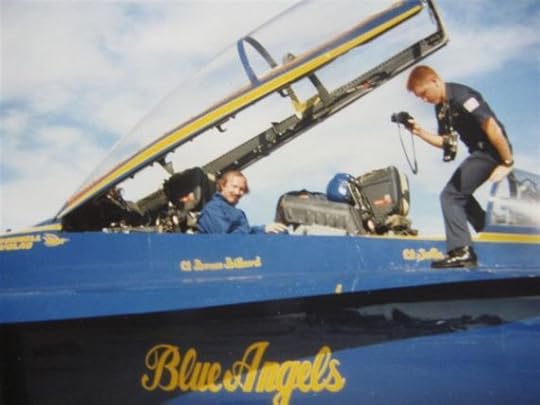 Richard Bangs flying with The Blue AngelsThe gifts of understanding are presented to those who travel and seek. It really doesn’t matter which category of travel undertaken, but rather in deciding how to travel. For to move is to permit change, and to open doors of perception. If opened slowly, considerately, then bouquets of clarity and compassion rush in, and we might indeed discover a quiet place in ourselves that is a state of grace.
Richard Bangs flying with The Blue AngelsThe gifts of understanding are presented to those who travel and seek. It really doesn’t matter which category of travel undertaken, but rather in deciding how to travel. For to move is to permit change, and to open doors of perception. If opened slowly, considerately, then bouquets of clarity and compassion rush in, and we might indeed discover a quiet place in ourselves that is a state of grace.
The “Ultimate Slow Adventure?”: A long life examined and enjoyed…
The post The Slow Travel Movement appeared first on We Said Go Travel.
November 15, 2013
My Trip to Yosemite
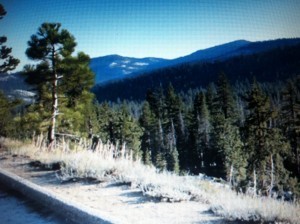 When I was in third grade, we had to do a report on a landform in the United States. I spent days trying to think of a topic. At the age of nine, I really didn’t know what the world was like. Of course, I’ve seen programs on the nature channel about national parks, but I never really understood the point of preserving these areas. I asked the teacher if I could do my report on Yosemite National Park, but she told me it was too broad of a topic.
When I was in third grade, we had to do a report on a landform in the United States. I spent days trying to think of a topic. At the age of nine, I really didn’t know what the world was like. Of course, I’ve seen programs on the nature channel about national parks, but I never really understood the point of preserving these areas. I asked the teacher if I could do my report on Yosemite National Park, but she told me it was too broad of a topic.
I was disappointed when I heard this news, but immediately a more specific topic popped into my head. I remembered something I had once read in a book about Yosemite. It was mentioned briefly, accompanied by only one fact: it was the tallest waterfall in the United States. I knew most people had no idea what Yosemite Falls was, but that was what excited me. I wanted the opportunity to prove myself to the other students. Most of them were bullies who had been spreading terrible rumors about me the whole year. I wanted to show them I was smart, and I did. I got an excellent grade on the project, and I was really proud.
I met a lot of challenges while I was doing this project, but I persevered and wrote a great essay. Unfortunately, I had to present it to the class, and I have always been afraid of public speaking. So, I asked my mother to help me practice. Even in elementary school, I had some experience writing, and my report instantly painted a beautiful picture in my mother’s head. She suddenly wanted to see Yosemite falls, and she wanted to go as soon as possible.
We planned the trip for summer break, but sadly, my mother developed cancer and had to go through treatment that summer. As soon as she finished chemotherapy, we rescheduled the trip to celebrate. We planned it over spring break, and I would be spending my birthday there.
The day spring break began, my mother woke me up at four o’clock in the morning. I was really tired, but I didn’t argue.
I was perfectly happy to show up at the airport at five, and then board the plane at around six thirty. The flight was long, and we stopped for a half hour in Houston. I ate lunch there, and then we boarded our connecting flight to Fresno. From there, we drove to our hotel, which was located about an hour outside of the park.
The next day, we began the drive to Yosemite Valley. We rode across bridges, through tunnels, and on long, winding roads which hugged the mountain sides, only feet from a sheer drop. I am still amazed that I wasn’t nervous, even though my parents were. Something inside me told me that there was something to look forward to. I was right; the first view of Yosemite Valley was the most amazing thing I have ever seen.
We came out of a long tunnel to see the valley which had been hidden from view. As soon as I looked, I was speechless with shock. Tall mountains surrounded us, reaching higher than any I have ever seen. It’s impossible to imagine the beauty in the valley unless you’ve been there yourself. I had expected a slope covered with sequoia trees and wildflowers. I found paradise instead. Round dome formations jutted out of the mountains. Huge trees, taller than I had ever thought possible, grew everywhere. I had expected to see only Yosemite Falls, but I could clearly see every waterfall in the valley. There we so many. The water rained down, every droplet glittering like a crystal. Leaves of every color littered the ground. Little red squirrels ran everywhere, along with other small native animals I’ve never seen before. When we parked and stepped out, the air smelled sweetly of wildflowers.
We spent twenty minutes enjoying the view and taking pictures, and then headed down to the café for lunch. I hastily gulped down a tuna fish sandwich, waiting to see more of the park. We spent the rest of the day in the valley, and my birthday seeing the giant sequoia trees, which had impressed me the most.
After my trip, I learned to love nature. The streets of the city seemed dull and lifeless. It took me weeks just to stop thinking about Yosemite for a moment. My personality has changed from my visit, and I began to think about the world around me from a new perspective. Yosemite was definitely the greatest place I’ve ever been, and probably the most beautiful part of the whole world.
About the Author: My name is Rebecca Rhodes and I am thirteen years old. I am currently enrolled in 8th grade and I am looking in to a writing prime for high school. I enjoy writing and love to share my experiences with others.
The post My Trip to Yosemite appeared first on We Said Go Travel.
Dave’s Travel Corner: Traveling in Sin is a MUST READ!
Thank you to Traveling Cricket and Dave’s Travel Corner for the review of our memoir, Traveling in Sin.
“If you are looking for some motivation to grab those plane tickets and pack those bags, “Traveling in Sin” is the book to read. With the wealth of information on land travel in Asia, on how to solve visa issues and also how to take advantage of the best things countries have to offer, the book is a must read for anyone who dreams of traveling the world.”
The review begins:
“When traveling, flexibility and solid team work are essential”- Lisa Niver Rajna
When I travel I love to read. It makes the long train, bus or flight times go by much faster. Therefore, on my recent vacation (September 2013) I started reading “Traveling in Sin” during my flight to Bari, Italy. I was immediately hooked.
The book is a travel memoir, a collection of stories, very useful travel information and quite a bit of romance. It is written in two voices: those of Lisa and George; which at first felt a bit …strange. I was afraid I wouldn’t be able to follow the story. But, as it turns out, the two voices actually complement each other, making everything easier to understand.
Lisa and George met online in January 2007. Soon after, in the summer of 2008, they went on their first trip together in Fiji. This is when George told Lisa about his dream of traveling the world. And that’s how their 11 months journey in Asia began.
“Traveling in Sin” tells the story of this couple, the journey that they follow as their relationship evolves during long term travel. Especially for Lisa, it is a journey of discovery: she loses weight, and gains courage and confidence. And George is there to help and encourage her.
READ THE FULL REVIEW
Buy the memoir, Traveling in Sin, at Amazon.com
WATCH: The Video Book Trailer
Traveling in Sin is a TOP TEN Hot New Release! from Lisa Niver Rajna
The post Dave’s Travel Corner: Traveling in Sin is a MUST READ! appeared first on We Said Go Travel.
Israel is Real
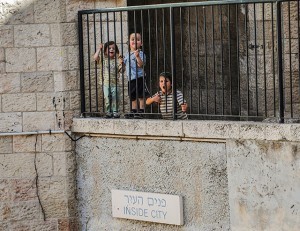 Shortly after accepting a full-time job at the French Theatre of Rome, I was invited to replace an employee – too far into pregnancy – on a secret destination journey. My friend and now boss, Frédéric Lachkar, had planned this surprise to reward his team members for their hard work and success of the musical Sans Papiers: 80000 tickets sold in over 80 Italian cities during the 2011/2012 tour. So instead of sweating in my new office, I joined in!
Shortly after accepting a full-time job at the French Theatre of Rome, I was invited to replace an employee – too far into pregnancy – on a secret destination journey. My friend and now boss, Frédéric Lachkar, had planned this surprise to reward his team members for their hard work and success of the musical Sans Papiers: 80000 tickets sold in over 80 Italian cities during the 2011/2012 tour. So instead of sweating in my new office, I joined in!
On the morning of June 5th, 2012, Fred’s beautiful wife dropped us off at Fiumicino airport. Aside from our guesses, we still didn’t know for sure where we were headed, so Fred let out a hint:
“Exactly 35 years ago, the Arab countries forced Israel to fight a war. It only took us six days to win and make them vanish!” He sniggered.
Considering his strong Jewish identity and passion for Israel, we weren’t too astonished – yet not less excited – when queuing to check-in for Tel Aviv.
Beppe’s olive skin, dark curly hair, and thick beard cost us a good half hour interrogatory, but we eventually made it through the Israeli customs, and rented a big enough car that would hold us all. Automatically, we picked our strategic positions for the week: Rémi and I rushed to the back to continue to laugh; Beppe, Vicky and Ele occupied the middle bench seat, Robby held the country map up front, and Fred cheerfully drove along the roads of his past.
We first stopped at Fred’s dear friends, Françoise and Jean, who had kindly offered to host us for the night. As we arrived in front of a little green gate, Fred pushed its black handle, and we followed him through a short passage that led to the main entrance. We rang the doorbell. A few seconds later, Françoise affectionately embraced our boss, and her large family appeared in the background: husband, children, and grandchildren gave us a warm welcome, and then quickly took our suitcases to the top of the wooden staircase.
“Tell them to go help themselves at the buffet.” Françoise told Fred in a Southern French accent that he rapidly translated to Italian.
On a blue and yellow tablecloth, Françoise had arranged traditional dishes loyal to kashrut or kosher (Jewish dietary laws). Also common to the Middle Eastern and Mediterranean cuisines, these included many colorful delights: pita bread, carrots, and celery to dip in a bowl of hummus, eggplant salad with mayonnaise, fried falafel and matzah balls, ptitim – or Israeli couscous – with tomato sauce… It was not even 6 p.m., but each of us grabbed a plastic plate, filled it thoroughly, and moved to the white table dressed outside in the patio.
Originally from Nice, Françoise and Jean had moved to Israel with their three children in 1991.
“As Jewish, we never questioned our choice; as parents we inevitably did.” Françoise revealed with a semi smile upon her face.
“Why?” I wondered.
“When a bus filled with kids returning from school explodes in the nearby street; when you could’ve spared your children with the military service, and end up sending them to Gaza instead; believe me, you begin to wonder whether Israel was a selfish choice.” While others were cracking jokes on the opposite side of the table, Françoise’s youngest daughter, Audrey, carefully listened.
“Either way, our children would’ve never accepted to leave. Israel is their home, their culture. Hebrew is their language, you understand?” I understood. My parents had also done a move from France to Italy in 1991. Still, it was different: we weren’t tied to a religion or a language. We spoke English and French at home, and attended international schools in Rome – a very safe city.
“How was the military service?” I asked Audrey who was about my age.
“Incredible. I had the time of my life, really!” She exclaimed.
You, with such innocent features! How could you have the time of your life with a gun in hand? I was shocked. Shocked and impressed. Because, despite the violence – that I don’t intend to diminish – there was some inspiring beauty to this: a beauty that my multicultural background would never enable me to fully seize or feel. Israel goes beyond the waving of a flag in the name of nationalism; it is about people, who – loyal to their religious and cultural ideals – crossed borders to stand together in a crowd before history’s uncertainties.
About the Author: Julie Beretta: With her multicultural French, American and Italian origins, Julie has always been a dedicated traveler. Since she discovered the sharing of her stories enabled her to travel some more, she also became a passionate writer – who now mainly strives to travel so she can write; and write so she can travel more.
The post Israel is Real appeared first on We Said Go Travel.
November 14, 2013
Uzbekistan: The Road to Samarkand
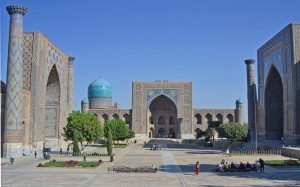 It’s dark and I am staring at the most incredible sight, lit up before me like a theatrical set awaiting a cast of thespians and minstrels to perform. Am I dreaming or am I really here? A car goes past behind me, its horn blaring that brings me out of my reverie and back into the real world, and, yes, I really am here.
It’s dark and I am staring at the most incredible sight, lit up before me like a theatrical set awaiting a cast of thespians and minstrels to perform. Am I dreaming or am I really here? A car goes past behind me, its horn blaring that brings me out of my reverie and back into the real world, and, yes, I really am here.
Registan Square, Samarkand, Uzbekistan.
“Why Uzbekistan? Where is it” my family and friends had asked. “In the middle of nowhere”, I told them and then showed them on the map the area of Central Asia, sandwiched in between China, Russia and India.
I came to Uzbekistan to satisfy a curiosity. Earlier in the year I had been to China and became fascinated by the history of the Great Silk Road and the countries of Central Asia through which it coursed on its way to the Mediterranean Sea and beyond to Italy and the rest of Europe. All caravan routes along the way seemed to lead to this place called Samarkand.
I had no idea what to expect, apart from what I had read on the internet and in the one guide book that I had managed to find. Even this did not have many pictures, so I was left to conjure up my own imagination and develop my own ideas of what I was going to encounter in this small and deserted country.
Well, what an extraordinary country…….a journey I will never forget. The scenery, the preserved and restored architecture, and the people I met were all quite remarkable.
From the wonders of the ancient city of Khiva situated in the desert of Western Uzbekistan to the 10 hour ordeal to cross the Kyzyl-Kum Desert to the city Bukhara, my travels eventually bring me to the “Jewel in the Desert” – Samarkand itself.
Samarkand will forever be associated with the Great Emperor Temur (better known as Tamerlane) who built and developed the city as the capital of his vast Empire. Born in 1336, Temur, a descendant of Genghis Khan, went on numerous successful military campaigns to secure an Empire that stretched from the Mediterranean Sea to the borders of China, but he always returned to his beloved Samarkand. During his lifetime up until his death in 1405, he was instrumental in building an array of quite stupendous feats of architectural engineering, of which the focal point of the city was, and still is, Registan Square.
I have seen pictures and, like the Taj Mahal in India, I have been told that pictures do not do it justice. You have to see it to believe it.
My first impression of Samarkand is that of a quite modern city. Certainly the outskirts of the city have numerous industrial and residential areas but I could see the turquoise domes and minarets in the distance so I must be heading in the right direction.
Before heading for the hotel, the guide was keen to whet appetites by paying homage at Temur’s mausoleum – Gur Emir. I stood transfixed in front of an enormous, wonderfully decorated portal through which I could see the dome of the mausoleum itself. The predominant colour of the millions of tiles is turquoise. The guide says that this is a rather understated monument for such a great warlord. If this is understated, what must the other sights be like?
Well, I was to find out the following day when I would be taken to see Registan Square.
We made our way from the hotel through the streets of Samarkand. We passed Gur Emir, which we had visited yesterday. I still think it looks pretty impressive but then we arrived at the viewing platform overlooking Registan Square and I experienced another ‘Taj Mahal moment’ when my jaw hit the floor.
WOW!
I just stood and stared at what is in front of me. Quite amazing!
It was difficult to appreciate the sheer size of the madrassah portals from a distance, but, up close, they are huge. I felt like an ant as I walked through into a magnificent quadrangle on the inside where students of Islam would have studied all those years ago. Now, the tiny rooms are converted into souvenir outlets and museums.
Now I’m here again because the guide had told me that the whole Square is lit up at night. Having resolved to miss dinner and take a wander down here to experience this, I have no regrets.
She’s right! What a surreal moment this is, seeing the huge façades lit up from the ground and the turquoise dome of the mosque floodlit against the night sky.
I’m really glad I went hungry to see this awe-inspiring spectacle.
Uzbekistan – a quite extraordinary experience.
About the Author: Peter Clarke is a travel writer and photographer who has been fortunate to have been able to visit some wonderful destinations around the world. He has published a number of pocket-sized guides illustrated with his own photographs.
The post Uzbekistan: The Road to Samarkand appeared first on We Said Go Travel.
Manila: One-stop, Non-stop Entertainment
Thank you to Johnny Jet for publishing our article, One-stop, non-stop entertainment in Manila, the Philippines.
We enjoyed our time in the Philippines this summer and look forward to sharing several articles with you about all the amazing places and activities we saw. Our hearts go out to the people of the Philippines after the recent typhoon.During the last fifteen months, my husband George and I have been traveling independently all over Asia. We knew we needed to return to Los Angeles for a family event in October so after being away since July 2012, we began to make our way back across the Pacific. Our last stop in Asia was Manila—capital of the Philippines—but we had a few issues along the way.
Our flight into Manila, on Air Asia affiliate Zest Air, was cancelled due to safety infractions. Passengers were therefore redirected on a two-hour Cebu Pacific flight to Manila from Kuala Lumpur. We arrived fatigued and a day behind schedule but fortunately our accommodations at the Remington Hotel were located within a few minutes of Manila’s airport. In fact, the Remington offers free transport from terminals one, two and three. Since we were flying to Bohol the following day, the hotel was an ideal location to spend the night.
Once at the hotel, we checked into the stylish and modern room meticulously maintained at a crisp 20 degrees Celsius (~70 Fahrenheit). The Remington Hotel is part of Resorts World Newport City Mall, home to an impressive collection of international cuisine and shops.
Read the full article: CLICK HERE!I loved sitting in Cinderella’s carriage!
For more detailed information about how to prepare to travel to and within the Philippines, refer to Rissa Gatdula-Lumontad’s book, “Philippines: 100 Travel Tips.”
In addition, Ricky Tio at Cebu Holiday Tours can assist travelers with detailed information on where to stay and what to do once in the Philippines.
About the Authors: Lisa Niver Rajna and George Rajna are co-authors of Traveling in Sin and co-founders of We Said Go Travel. They are accomplished writers, speakers and travelers who are members of the Traveler’s Century Club, a unique travel club limited to travelers who have visited one hundred or more countries.
The post Manila: One-stop, Non-stop Entertainment appeared first on We Said Go Travel.
France: Ancient Dignity
Travelling is my passion. It’s the thrill of experiencing the blend of ancient and modern in places like Athens or Rome, or knowing that anything can happen such as having to get off the track outside a village in Thailand to make way for a water buffalo carrying two small children on her broad back.
Over the past few decades I have been extremely fortunate to have seen some amazing structures and I will always be humbled and moved by the accomplishments of people of the past. They remind us that brilliant minds have always been, and were able to design and build without the use of electricity and the need for computers. There are two places in particular that had a profound effect on me that I would like to share.
On a camping trip to France in 1976, I visited the Gier Aqueduct, situated to the north of the city of Lyon. This incredible aqueduct stretches for about 53 miles and was built to bring water from the Gier River to Lyon. I believe it is the longest known of the Roman aqueducts.
The section I saw that early summer day took a lone path through waxy colored fields. It’s hard to really describe how I felt standing in that dry yellow field in the midday heat looking at those ancient arches stretching silently into the distance. The stone was cool to the touch, pitted and uneven from centuries of exposure to the elements, and there was a faint woody smell in the shadows from the moss and ferns growing in small damp patches. The Romans were certainly a people with purpose and vision, and I wonder if the engineers who designed it had the notion that centuries later someone would stand in this spot and marvel at their brilliance. Although now in ruins, the Gier aqueduct stands strong and able, and I somehow felt comforted to be in its presence.
The second place that truly had an impact on me was in Greece. While on a trip to in Athens, I met a couple of New Zealanders, and a British man travelling with his mother. This lady had been reading about the excavations of the tombs at Mycenae where Heinrich Schliemann had found the gold funeral Mask of Agamemnon and other treasures. We all agreed that it seemed like good idea to pool our money, rent a car and drive to Mycenae .
The site of the citadel at Mycenae sits on top of a hill in the Peloponnese Mountain region and is thought to have been inhabited from about 2000 BC. It overlooks olive groves and countless rows of orange trees, and in the distance to the south is the Gulf of Argos.
To enter the citadel, you walk through the magnificent Lions Gate. These two lionesses, one positioned each side of a column on top of what looks like an altar may have been considered guardians of the city. When I first saw the Lions Gate, I wondered if the people who designed it had ever seen a real lion, or did they work from sketches. The heads of the lionesses are long gone, but centuries later their bodies still emanate a sense of power. There are many ideas about what the gate represents, but to me it makes sense that the people of Mycenae considered them protectors.
It was a crisp January day when I sat and listened to the wind blowing through the ancient stone walls, carrying with it the tinkling of bells that hung around the necks of the goats in the village below. There was a hint of salt in the air and I fancied I could hear the marching of soldiers returning home from the Trojan war as they made their way up the hill. Surely the lionesses must have been a most welcome sight. Were these men reassured that their families had been protected by these mighty guardians in their absence? Had the people of Mycenae believed the gate would keep them safe? To me the Lion’s Gate is not only a symbol of strength and protection, but also of trust.
I will always be in total awe of the Romans for their ingenuity and feats of engineering, and of the Greeks for their philosophy and dedication to architectural beauty. Wonder and amazement truly describes my feelings when I remember my visits to the Gier Aqueduct and Mycenae. They stand with a quiet dignity, bringing a continuity from the past into the present and will continue to be tangible reminders of strength and endurance on into the future.
About the Author: My name is Louise Zontek. I was born in Sydney, Australia and have lived in the United States since 1980. I love to travel and have a particular passion for ancient civilizations and history.
The post France: Ancient Dignity appeared first on We Said Go Travel.
Reasons to Spend This Christmas Season in Istanbul
Istanbul is probably not on the forefront of many peoples mind when it comes to a Christmas vacation destination, but give this post a read and I might just convince you otherwise.

Despite not celebrating the Christmas holiday itself, Istanbul is still more than alive for the festive period. There’ll be decorations, Christmas trees and lights aplenty all along the streets – the city looks incredible lit up and you’ll really be able to feel the atmosphere all around you. While the locals may be fixed on New Years, there’ll be plenty of organised Christmas activities by the active ex-pat community.
Of course, Christmas isn’t Christmas without the religious celebration and the largest Catholic Church in Istanbul, San Antuan is the place to be for Christmas mass.
For the inevitable last minute gift shopping, look no further than the Grand Bazaar. Don’t forget to brush up on your bargaining skills beforehand – practically everything is for negotiation. It’s easy to get overwhelmed by the 60 odd streets and throngs of people, so make a plan ahead of arriving to avoid a stressful experience. The top buys here are the carpets, scarves and jewelry.

Grand Bazaar

By Marc Tarlock , via Wikimedia Commons
New Years eve is a big Western celebration or rather a good excuse for a wild party and Istanbul is a unique place to experience the ringing of the New Year. Clubs & bars in Beyoğlu will be in full swing and you won’t have to look hard to find a great place to join in with a rendition of Auld Lang Syne. Don’t miss out the super street party in the Nişantası district!
What better way to recover those delicate post New Year heads, than a trip to the Hamam, or Turkish bath. The absolute best way to experience the Hamam, is to ask for the traditional style bath where you’ll be treated like a king. For an authentic experience, visit the Kasimpasa district where the Grand Hammam is located – built in 1533, it’s like stepping back through time!

Speaking of stepping back in time, the history of Istanbul, Constantinople, Byzantium stretches far far back in time and just by simply walking around you’ll spot ancient architecture, ruins and museums aplenty. A great way to see a lot in a short time for cheap – go on a walking tour of the city. Check out your hotel lobby, Trip Advisor or notice boards at tourist destinations and you’ll most certainly find a walking tour brochure. It’s also a good chance to meet up with fellow tourists and travelers.
A 7km walk along the ancient city walls is to appreciate how resilient and how formidable this great city was through the ages. Download the online English guide so you know what’s what on the walk.
If you’re looking to take a break from walking around, a leisurely afternoon cruise on the Bosphorous river is a must. While floating along the waterway that divides Europe and Asia, you’ll pass by the old Palaces which remain as magnificent as they once were. You won’t have to look very hard for them due to their imposing position on the banks of the Bosphorous, but do take in the Dolmahache Palace, and the exquisite Ciragan Palace – which is now a world famous luxurious hotel. I can see why!
[image error]
Ciragan Palace
One of the truly unique experiences of a holiday to Istanbul is a daytrip to the Princes Islands. This group of 9 islands have banned motorised transport so they are very tranquil in contrast to the bustling city. The favoured way to get around is on horse drawn carriages and it’s a relaxing tour around the amazing Victorian architecture.
Visiting Turkey is a wonderful opportunity to partake in some authentic hookah smoking. Take a visit to Yeniçeriler Caddesi and look around for the plumes of smoke rising from the cafes. While you’re at it, you can try the Turkish tea, the national drink and served everywhere. It’s the simple pleasures in life!

Nargile

By Travel-Turkey , via Wikimedia Commons
For food, you are really spoiled for choice. Obviously you’ve got the famous Turkish Delight, which you can buy fresh almost anywhere. I recommend trying out the different flavours, especially Pistachio. Walking around, you’ll see little Doner places dotted everywhere. It’s a cheap and filling snack but there’s so much more.

By TheMightyQuill, via Wikimedia Commons
If you’re into fish – try the local favourite Balik-Ekmek, which is a fried fish sandwich. It’s much much better than it sounds! Kumpir is one my personal favourites, it’s simply baked potato with a variety of fillings, but so so good.
For desert, you won’t miss the many Turkish ice cream vendors along the streets. They’re often up to tricks and showing off their ice cream magic to curious crowds. Far from home at Christmas, you might be surprised to find that roast chestnuts are a common and welcome winter treat at a lot of street corners in Istanbul. For a few lira, you’ll have delicious hand warmers.

Turkish Ice-Cream Vendors

Shoestring , via Wikimedia Commons
So there you have it, a million different reasons to visit Istanbul this winter vacation. If you’re reading travel websites, it’s likely you didn’t need much of a push anyway!
Have you been to Turkey recently? What was your experience, have you got any tips or must-sees not on our list? Let us know in the comments below!
The post Reasons to Spend This Christmas Season in Istanbul appeared first on We Said Go Travel.
November 13, 2013
Liverpool: This is Anfield
 While planning my trip to visit my brother in the UK, going to Liverpool was top of my bucket list. As a passionate Liverpool FC supporter, I was prepared to do anything to cross this off my list. I made all the arrangements for my trip to Liverpool and spent half of my earnings on a ticket to watch Liverpool vs. Tottenham at Anfield.
While planning my trip to visit my brother in the UK, going to Liverpool was top of my bucket list. As a passionate Liverpool FC supporter, I was prepared to do anything to cross this off my list. I made all the arrangements for my trip to Liverpool and spent half of my earnings on a ticket to watch Liverpool vs. Tottenham at Anfield.
Being South African, the weather on that side of the world was extreme for me so I piled on a couple of layers and departed London Euston Station on a freezing, snowflake scattered Sunday morning at 09:15 am. I arrived at Liverpool Lime Street Station three hours later. As I stepped off the train, I was struck by a surge of emotions that overwhelmed me. I exited Lime Street Station and took a cab to Knowsley where I was booked to spend the night at the Holiday Inn Express. Along the way, we passed sign boards pointing to Anfield and that’s when I realised what that rush of emotion was – being in Liverpool felt like I was home.
I anxiously checked my GPS to ensure that we were heading in the right direction. The drive seemed longer than expected as we headed towards the outskirts of Liverpool city. I eventually reached the hotel and handed the driver a £50 note. He gave me a stern look and said “don’t you have smaller change; we don’t often get £50 notes.” My heart thumped nervously, he seemed unimpressed. I asked if he had a card machine and, just my luck, it was out of order. I ran into the hotel for change, paid the driver and headed back to the hotel to check in. The receptionist handed me my match ticket, excitement rose within me. I was going to Anfield!
After taking the time to get dressed up (just in case Steven Gerrard happened to spot me), I called for a cab to Anfield. The cab driver was a big built, bald, friendly man. Along the way, we conversed about soccer and exchanged holiday stories, he told me that he’d love to visit South Africa but it was just too hot which was not good for him because he can’t stand the heat. I listened carefully, trying to decipher every word of his Scouse accent. We eventually reached Anfield. I paid the driver, thanked him and bolted out of the cab. My excitement grew fast and I couldn’t wait to get into the stadium.
This Is Anfield. I looked up from the street to the sight of my dreams. I entered the gates and made my way to the stadium. My ticket included lunch so I filled my tummy before heading to the stands. The steward checked my ticket and directed me through the doors. As I walked down the stairs to find my seat, each step took me closer to the field. My heart pulsated through my chest. I was seated in the front row, a mere stretch away from the field. Brad Jones (Liverpool’s second goalkeeper) soon emerged from the tunnel across the field and headed towards me to warm up. Shortly after, the rest of the squad joined him. I had stars in my eyes – Gerrard, Sturridge, Suarez, Agger, Lucas, Carragher, etc. I instinctively waved at them, thinking they’d recognise me since I see them every weekend. I quickly dropped my hand when I realised that they don’t know who I am.
My dreams were unfolding before me, a front row seat at Anfield, and the players not far off. The stadium soon filled up and the players ran out onto the pitch again. That’s when my dream was perfected. The anthem filled the air “When you walk through a storm, hold your head up high and don’t be afraid of the dark, at the end of the storm, there’s a golden sky, and the sweet, silver song of a lark. Walk on through the wind, walk on through the rain, though your dreams be tossed and blown. Walk on, walk on, with hope in your heart and you’ll never walk alone, You’ll Never Walk Alone.” Tears filled my eyes as I sang along with the crowd.
Liverpool won 3-2 in a very high paced game with nail biting moments. The atmosphere was electrifying, I screamed with elation at every goal we scored and cursed at every decision that went against us. It was a day which brought me closer to my team, to a city that felt like home. I departed Liverpool the following day with tears in my eyes, feeling as if I were leaving home forever. One thing is for sure though, I will return but for now Liverpool and Anfield are firmly cemented in my heart.
About the Author: Deepa Chibba: I am a passionate football fan that loves the adventure of travelling. I love animals and believe that they need us to protect them and love them unconditionally. Twitter handle – @deepa910
The post Liverpool: This is Anfield appeared first on We Said Go Travel.
Spain: One Million Steps
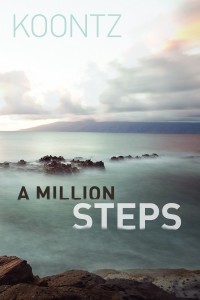 A million is a rough estimate of the number of steps I took while walking the Camino de Santiago. I made the calculation on day 13 of my trek as I walked along a portion of the path that was parallel to a highway with kilometer markers. Over the course of a kilometer, I counted 1,153 steps. I did the math and discovered that I would take a total of 909,717 steps on the trail between St. Jean Pied-de-Port, where it began, and Santiago de Compostela, where it ended. I added in another 3,000 or so steps per day to cover the walks to dinner and short hikes for sightseeing. One million steps seems a good estimate.
A million is a rough estimate of the number of steps I took while walking the Camino de Santiago. I made the calculation on day 13 of my trek as I walked along a portion of the path that was parallel to a highway with kilometer markers. Over the course of a kilometer, I counted 1,153 steps. I did the math and discovered that I would take a total of 909,717 steps on the trail between St. Jean Pied-de-Port, where it began, and Santiago de Compostela, where it ended. I added in another 3,000 or so steps per day to cover the walks to dinner and short hikes for sightseeing. One million steps seems a good estimate.
Like so many things in life, the best way to prepare for the journey is to commit. Depending on your fitness level, a budget of 30-45 walking days is a nice place to start. Add two days on each side for travel. The next big decision is determining the best time of year for your walk. Late spring works well to avoid the crowds, but there will likely be snow at the higher elevations. Summer is by far the most popular time, but be prepared for large crowds. During this season, approximately 1,000 people start each day. The fall is a nice time, but try to make sure that you arrive in Santiago no later than November 15. During the shoulder seasons, there are about 300 people that embark on the path each day. Book your round-trip flight to either Paris or Madrid. The American Pilgrims on the Camino (APOC) has an excellent board on Facebook that can answer all types of questions including how to arrange for local transportation to your starting point.
This is a minimalist trip, so packing is relatively easy. Your pack should be 30-50 liters and make sure that the waist strap rests comfortably on the hip bones. If the pack is too short, you will have a miserable time trying to carry the weight on your belly. Take the John Brierley Guidebook, three pairs of socks, three undies, one pair of hiking shorts, one pair of long pants with removable legs, one short sleeve wicking shirt, one long sleeve wicking shirt, sleeping bag, a windbreaker, wool gloves, a basic first aid kit, flip flops (for the shower), hiking shoes or boots, sneakers, and a hat. Many people take rain gear, but I chose to buy as needed in Spain. Add some basic toiletries and you now have just about everything you will need. As a general rule, the pack should not exceed 15% of your bodyweight. While the shopping experience is unique and the selections are a bit limited, you can buy anything that you need along the trail. Every ounce counts so when in doubt…..leave it out!
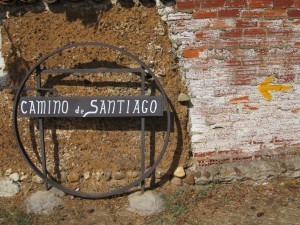 You will likely be walking between 11-16 miles per day, so do not start cold turkey in Spain. Try to walk a minimum of 20 miles per week for at least six weeks prior to your departure. As you get close to take-off time, try add several 15 mile days. The weekly training will get you in walking mode and will allow your feet to become accustomed to the footwear. Without preparation, blisters will haunt you.
You will likely be walking between 11-16 miles per day, so do not start cold turkey in Spain. Try to walk a minimum of 20 miles per week for at least six weeks prior to your departure. As you get close to take-off time, try add several 15 mile days. The weekly training will get you in walking mode and will allow your feet to become accustomed to the footwear. Without preparation, blisters will haunt you.
The difficult part of making the trip is to manage your expectations. The best way to do this is to leave them behind! When you arrive, everything you encounter will likely challenge your comfort zones. You sleep in bunks, walk five to seven hours per day, meet people from all corners of the world, lose convenience, eat what is available, face adversity, and embrace joy. This is the arena where you grow as a person.
Unlike the daily routines of life, every single day is filled with uncertainty. The terrain, weather, distance, stamina, and acquaintances change on a daily basis. In this “challenged” environment, you will likely be sucked into the now. With so many unknowns, there is little time to waste on the past or the future. Spending 30-45 days in this zone will likely help you to rearrange your emotional backpack.
Prior to my trip, the veterans told me that the first third of the trip is for the body, the second for the mind, and the final third for the soul. Walking across the Pyrenees Mountains and subsequent hills (180 miles) challenges the muscles and stamina finds a new foundation. The Meseta is 120 miles of flat and barren ground. With little scenic distraction, the mind is forced into meditation or inward reflection. With a strong body and clear mind, the final 200 miles is for the soul. The lush foliage, steep mountains, and small streams compliment the landscape. Realizing that the end is near, my soul became a sponge and savored every tiny moment.
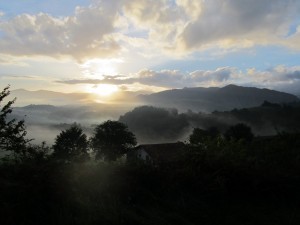 By the end of the road, you will experience some type of a transformative experience. For some the change is monumental, for some the change is small, for everyone……… there is change. Like your time on the trail, be prepared for a never ending journey.
By the end of the road, you will experience some type of a transformative experience. For some the change is monumental, for some the change is small, for everyone……… there is change. Like your time on the trail, be prepared for a never ending journey.
Reflections:
I had no eureka moments on the Camino. At kilometer marker 348.6, I uncovered no little vault with all the answers to life. Instead, just like life, I experienced a series of meaningful and small insights. I believe we all have an internal light, and the Camino acts as a rheostat to greatly increase the intensity. With care and awareness, I hope to keep that light glowing brightly until my last breath.
I continue to treasure the small moments that make up each and every day. A simple smile, a nice cup of coffee, a beautiful sunset, or some random act of kindness provides fuel for my light. When it all becomes too hard, I still use my “Refresh” move, walking in a circle, with or without my walking stick, to get a completely new perspective.
I am letting go of worry. Chronic worrying is detrimental to happiness. It is impossible to be happy and to worry at the same time. It is like trying to view a sunset with pirate patches covering both eyes.
For many years, people had extolled the virtues of deleting worry from my life. This was easy to say, but difficult to implement. During my million steps of reflection on the Camino, I spent some quality time focusing on the significant portion of my life that had been completely wasted on worrying about things outside of my control. The only thing we ultimately control is our reaction to events in our lives. I am spending much more time aligning myself with what is happening as opposed to trying to control what will or will not occur.
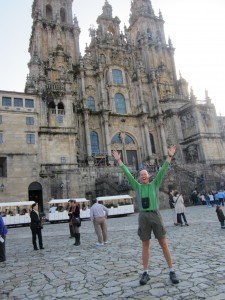 Another of my foundations for keeping the light aglow is to live in the Now. It is impossible to eliminate the past or avoid all pleasant or unpleasant memories. However, when I visit my past now, I try to go in, learn, and get the hell out! I am not going to be anchored by some event or trauma from my past. The same goes with the future. While hopes and dreams for a bright forecast are always present, I refuse to walk the rest of my life with eyes solely focused on the horizon. I yield to the current moment.
Another of my foundations for keeping the light aglow is to live in the Now. It is impossible to eliminate the past or avoid all pleasant or unpleasant memories. However, when I visit my past now, I try to go in, learn, and get the hell out! I am not going to be anchored by some event or trauma from my past. The same goes with the future. While hopes and dreams for a bright forecast are always present, I refuse to walk the rest of my life with eyes solely focused on the horizon. I yield to the current moment.
The Camino strengthened my relationships with friends, family, and myself. While meeting many friends from various nations made the trip a wonderful experience, the most enriched friendship I developed was with myself. It was a joy to rearrange my emotional backpack. My spiritual awakening made me realize that we are all connected and have a purpose. I am much more open to letting people into my life, and more importantly, to learning about their lives.
About the Author: Kurt Koontz is the author of A Million Steps, a book about his journey on the Camino de Santiago. Website, Twitter, and Facebook.
The post Spain: One Million Steps appeared first on We Said Go Travel.
We Said Go Travel
We Said Go Travel is a global community of over sixteen hundred writers with articles from every continent.
Stories are shared with photos and video from a perspective of the transformative power of travel. We Said Go Travel has hosted live and online events as well as travel writing contests around the world. ...more
- Lisa Niver's profile
- 57 followers


